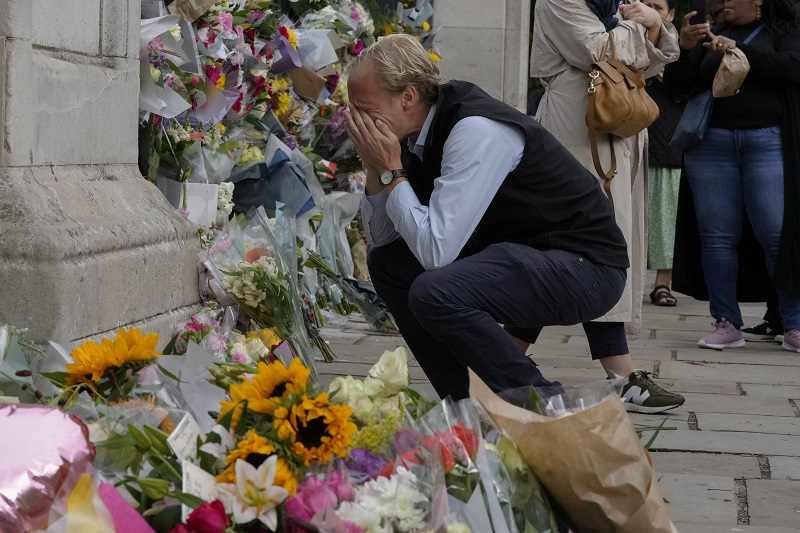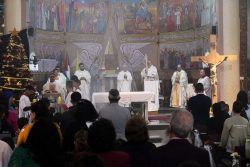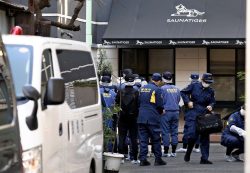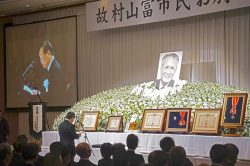
A mourners is overcome with emotion as he pays his respect at the gates of Buckingham Palace in London, Friday, Sept. 9, 2022.
15:25 JST, September 11, 2022
LONDON (AP) — By early afternoon, the scent of thousands of lilies and roses floated in the air outside Buckingham Palace. But the pilgrims kept arriving, bearing still more bouquets and notes of endearment addressed to the only queen most have ever known.
The scene outside the wrought iron gates was just as Nick French expected. But when he left a London hospital Friday, still shaky 10 days after surgery for prostate cancer, there was no question he would join them. Setting out on foot for an hour-long walk across the city, French searched through seven mostly sold-out florist’s shops until his arms were filled with blossoms of crimson and cream, pink and purple.
“I felt the need to come right down here,” said the 50-year-old social services consultant from nearby Kent, standing behind a police barricade. True, Elizabeth II, born to royalty and bound by duty, had lived a life of palaces and pomp. But in the queen’s decades of steadfast stewardship, French said, an ordinary man had found an inspiration and kindred soul.
Elizabeth’s life, “brings me hope because the queen was always an incredibly charitable person, a decent person even in the face of great adversity,” he said, “And that gives me a role model to try and move on in my own life, post-cancer.”
A day after the longest reigning monarch in British history died at 96, French’s tribute echoed through the crowds that thronged to Buckingham and the memorial plaza over which the palace presides.
Those in attendance were, of course, self-selected — people who cared for the queen and had come to express their affection. But the pilgrimage was remarkable for more than just its size; it was striking, too, for how it underscored the multitude of roles visitors say the monarch occupied in the lives of those she could never know.
“You inspired generations of young women like me to serve the great nation that thrived under your leadership,” read one note penned in purple marker, left at the gate.
“Farewell, my dearest,” read another, attached to a bouquet of yellow roses. “Thank you ma’am … for being a beacon of hope and stability in troubled times.”
And yet another: “We thank you for everything you stood for. For your sense of duty, your care, your compassion and of your love for us, your people.”
The outpouring of flowers and heartfelt notes in public places evoked, for those old enough to remember, another somber week in London 25 years ago — the days after Princess Diana, the queen’s onetime daughter-in-law, was killed in a car crash in Paris. Then, a nation poured out its public grief in a way not entirely dissimilar.
For David Hunt, a 67-year-old retiree from the British Library, the queen was a symbol of a bygone era and her death a reminder of just how much everything has changed since her reign’s early days in his childhood. And Claire McDaniel, 48, said she came when she finished work in a skin-care shop because it felt like the right thing to do for a monarch who, for her, felt almost like a grandmother.
“During the pandemic she came on TV and said, `This is bad, but it will get better. We will see each other again and get together again.’ And I think, as a country, it was just what we needed,” McDaniel said.
Not far away, classmates Adam Al-Mufty and Oliver Hughes, both 16 and in school uniforms, said they had come to Buckingham Palace to observe a chapter of history. But there was something more.
“She represented all of us,” Al-Mufty said, acknowledging the unlikeliness that a teenage student and a sovereign could relate to one another. “She was very down to earth.”
French, who came to the palace after an MRI to check that recent surgery had removed all his cancer, said his fondness for Elizabeth began in childhood but grew stronger in recent years.
After French’s father died in 2019, he said he found solace observing the queen’s grace and solidity at the funeral of her husband, Prince Philip. As she grew older and her own health faltered, her determination to enjoy the places and things she loved — while maintaining her role as queen — provided him inspiration, he said.
When he arrived at Buckingham Palace on Friday, he arranged four small bunches of flowers into a generous bouquet held together with a hairband given to him by another admirer in the crowd. At the barricade, he handed them to a police officer, who promised to find a good spot at the base of the palace gates.
It provided small solace. But in the weeks to come, the pain of losing Elizabeth will be difficult to hide, said McDaniel, the retail worker. After all, the queen’s face and name are everywhere — on Britain’s money and postal stamps, on an air terminal at Heathrow and on London’s newest subway line.
“It will be hard, but we’ll get through it,” McDaniel said. “That’s what we do. We’re English. We’ll have a bit of tea and carry on.”
"News Services" POPULAR ARTICLE
-

American Playwright Jeremy O. Harris Arrested in Japan on Alleged Drug Smuggling
-

Japan’s Nikkei Stock Average as JGB Yields, Yen Rise on Rate-Hike Bets
-

Japan’s Nikkei Stock Average Licks Wounds after Selloff Sparked by BOJ Hike Bets (UPDATE 1)
-

Japan’s Nikkei Stock Average Buoyed by Stable Yen; SoftBank’s Slide Caps Gains (UPDATE 1)
-

Japanese Bond Yields Zoom, Stocks Slide as Rate Hike Looms
JN ACCESS RANKING
-

Keidanren Chairman Yoshinobu Tsutsui Visits Kashiwazaki-Kariwa Nuclear Power Plant; Inspects New Emergency Safety System
-

Imports of Rare Earths from China Facing Delays, May Be Caused by Deterioration of Japan-China Relations
-

University of Tokyo Professor Discusses Japanese Economic Security in Interview Ahead of Forum
-

Tokyo Economic Security Forum to Hold Inaugural Meeting Amid Tense Global Environment
-

Japan Pulls out of Vietnam Nuclear Project, Complicating Hanoi’s Power Plans


























